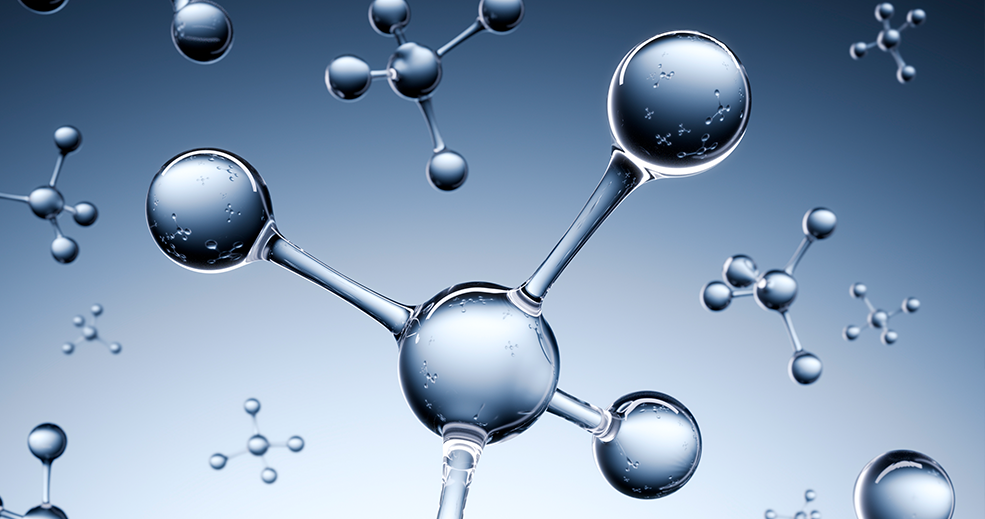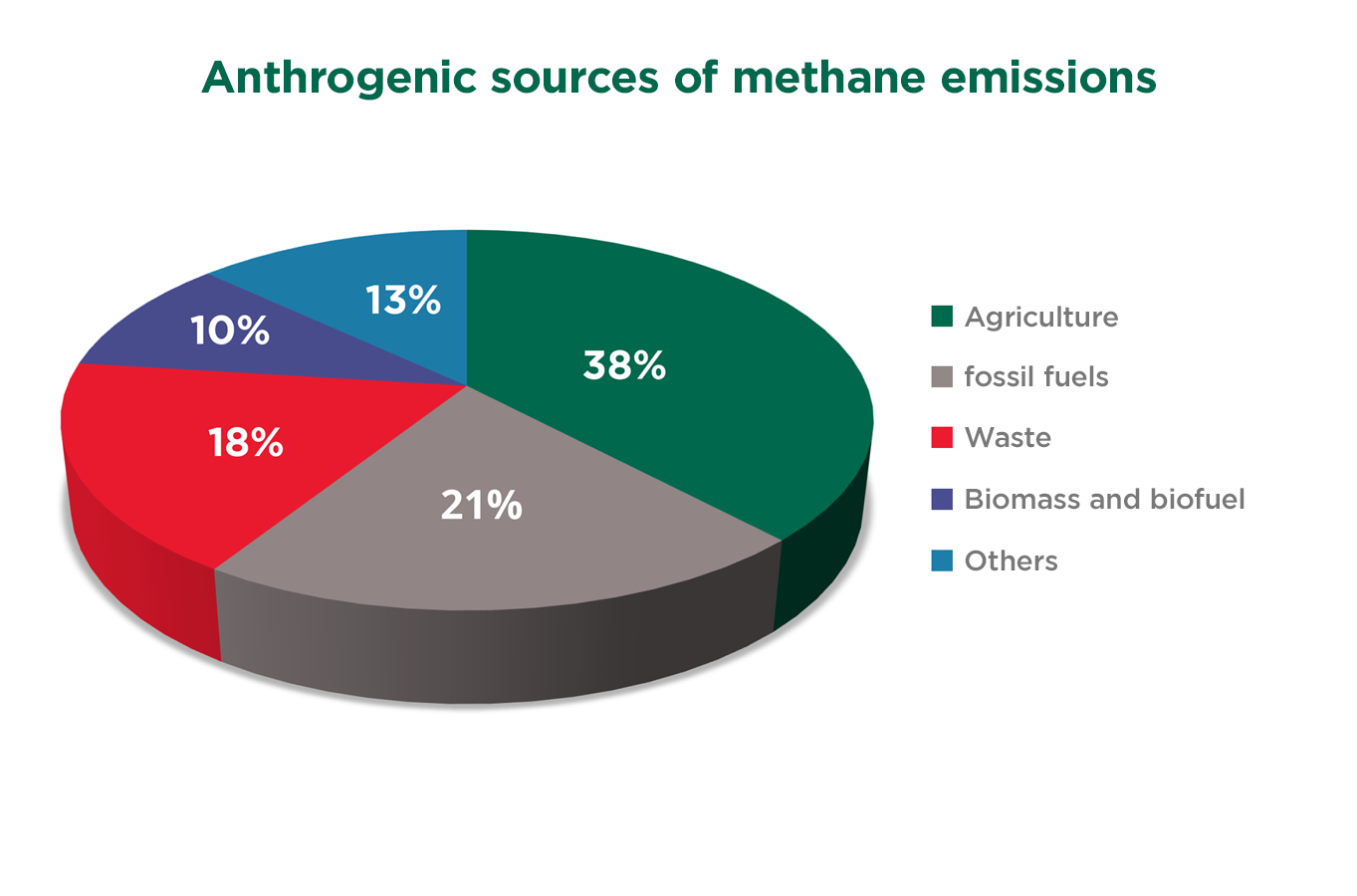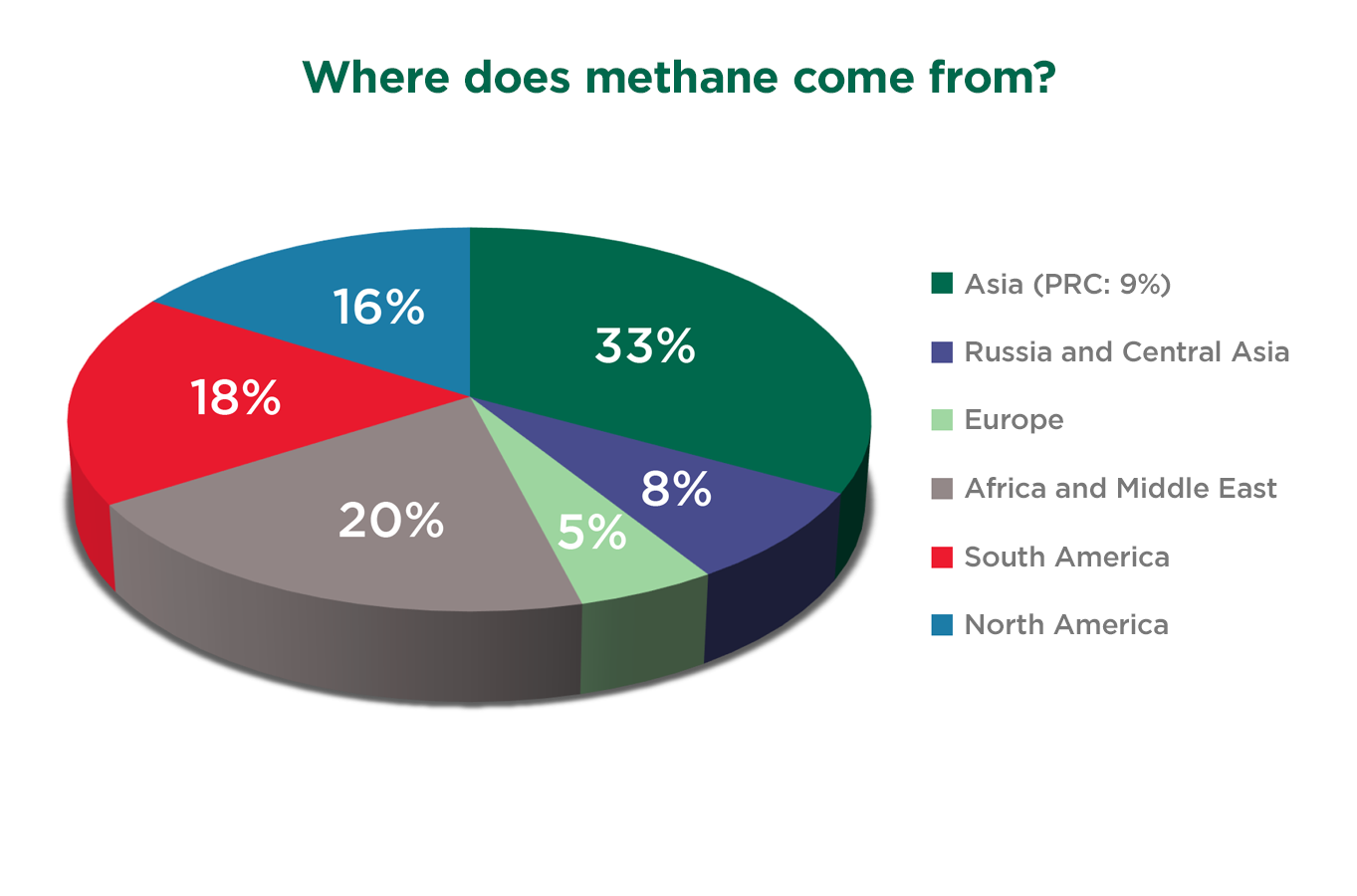
It is colourless and odourless, twice as light as air, and is found everywhere on land, as well as at the bottom of the ocean. It warms the air 25 times more than carbon dioxide (CO2), but dissipates into the atmosphere after about ten years. It is responsible for a quarter of global greenhouse gas emissions, but is often the forgotten enemy in the fight against climate change – despite warnings from scientists. You’ve guessed it: it’s methane – the primary component of natural gas and biogas.
More complex than carbon dioxide, there are still gaps in what we know about methane, although it is playing an increasingly important role in scientific research and climate policy. Overview and current status of the other greenhouse gas.
A powerful greenhouse gas
Methane was once known as “marsh gas” because it is concentrated in wetlands and was discovered in 1776. Composed of one carbon atom for every four hydrogen atoms (CH4), it is naturally present and relatively abundant in the natural environment. It is the simplest and only hydrocarbon that can be obtained by a natural biological process, namely the fermentation of organic matter in an oxygen-free (anaerobic) environment.
Methane was not identified as a greenhouse gas until 1976. It absorbs some of the infra-red radiation emitted by the Earth and prevents it from escaping into space, thus contributing to global warming.
Methane is a fuel with great potential. Combusting it results in carbon dioxide and water vapour, both of which contribute to the greenhouse effect, as well as a large amount of energy in the form of heat.
Methane is arguably the most dangerous of the greenhouse gases (GHGs) since its warming power is far greater than that of CO2. On the other hand, since methane has a lifetime in the atmosphere of “only” 10 years (compared with 100 for CO2), its global warming potential over 10 years is 25 times more powerful than CO2. Methane is thus the second most important greenhouse gas, responsible for about a quarter of GHG emissions. According to the IPCC, it is responsible for 0.5 °C of the 1.1 °C temperature increase since pre-industrial times. According to the UN, halving methane emissions would prevent an increase of 0.3 °C by 2045.
However, the global economy is not moving in this direction. Indeed, after a sharp increase in the 1980s and 1990s, global methane emissions were virtually stable until 2007. They have since resumed their increase, particularly in the agriculture and energy sectors, in Asia and Africa. Researchers from the Global Carbon Project have found that global emissions have increased by 10-15% from 2007 to the present, undermining the international community’s goal of limiting global warming to 2 °C by the end of the century.
In any case, it is essential to understand the different sources of methane before seeking to reduce emissions. While the origin of CO2 emissions is easily identifiable (the burning of fossil fuels), scientists are struggling to identify which factors are responsible for the increase in methane emissions.
Where does methane come from?
Methane is the most common natural hydrocarbon found in the air and subsoil in the form of significant quantities of natural gas. To simplify matters, we can distinguish between emissions of natural origin (40% of the total) and those of human or anthropogenic origin (60%).
- Natural emissions: methane is naturally released from low-oxygen wetlands such as marshes, mangroves or lagoons, as well as from lakes, rivers or volcanic hot springs. Researchers have found that emissions increase as temperatures rise. This essentially means that lakes could emit three times as much greenhouse gas as they do now. Indeed, by increasing the concentration of organic matter containing carbon, the rise in temperature favours the assimilation of this matter by micro-organisms which release the carbon in the form of CO2 and methane.
But the greatest threat comes from northern Siberia and Canada, where dozens of huge craters – up to 80 metres in diameter and as deep – are resulting from gas explosions, released because of global warming. In fact, the permafrost soil is now beginning to melt in summer and the organic matter it contains is decomposing, producing methane and CO2, sometimes resulting in explosions. It is estimated that there are several thousand of these gas “bubbles” with CO2 concentrations that are 25 times greater that of the atmosphere and 1,000 times that of methane. A fully-fledged climate time bomb that scientists are beginning to study and model.
And in the 2000s, researchers discovered that plants, fungi, algae and some bacteria can produce methane in the presence of oxygen in very large quantities, i.e. 10 to 30% of annual global emissions, a phenomenon that is mainly seen in hot tropical regions.
- Emissions from human activities: the main anthropogenic causes are livestock breeding and manure spreading, which together account for 30% of global methane emissions. Herbivores (cows, sheep, goats, horses) do not fully digest their food, which ferments and produces methane, 95% of which is evacuated by belching. In 24 hours, a cow releases between 100 and 500 litres of gas, three times more than a horse and ten times more than a sheep. According to the INRAE (National Research Institute for Agriculture, Food and the Environment), French cows emit the equivalent of 15 million cars’ worth of methane every year. Not to mention their droppings, which emit gas as they decompose.
As wetlands flooded by humans, rice fields also emit a significant amount of methane – accounting for approximately 8% of global emissions.
After agriculture come fossil fuels (oil, gas, coal), which account for 21% of global methane emissions. This methane can be trapped in coal seams. It is also present at all stages of the oil industry and operators prefer to burn it in flares rather than risk a methane explosion at a refinery. Natural gas leakage during its extraction, transportation, processing and distribution appears to account for up to 3% of global production. Using satellite imagery, scientists have identified 1,200 methane plumes around the world, all of which can be attributed to oil and gas development. The climate impact is enormous, comparable to the traffic conditions generated by 20 million vehicles over a 12-month period. Recent studies have also revealed that natural gas leaks have been underestimated by about 30%. In the United States, for example, where it is more profitable to abandon a well than to shut it down, it is estimated that there are already two million abandoned wells in the country, and these are still releasing methane into the atmosphere. Even more worrying are the studies conducted by researchers which show that mining shale gas emits much more methane than mining conventional deposits. The CO2 equivalent footprint of a shale gas well over 20 years appears to be between 30 and 50% higher than if coal had been used to produce the energy. This finding may partly explain the recent increase in methane concentrations in the atmosphere.
The third source of anthropogenic origin, accounting for 11% of methane emissions, is human waste, the storage sites of which ferment and emit large quantities of methane, sometimes called “landfill gas”. Biogas produced in sewage treatment plants, waste disposal sites or landfills can be recovered and used as electricity, heat or automotive fuel. A number of successful experiments have been carried out in France, Germany and Scandinavia, but the economic profitability of these installations is far from certain.
Finally, other sources of methane emissions include:
– biomass (10% of emissions), which comes from the incomplete combustion of plants and especially from their natural organic decomposition, such as dead leaves from undergrowth;
– The ocean floor contains large quantities of methane hydrates that could release methane if the temperature increases. Like the permafrost or the submerged permafrost of the eastern Siberian Arctic plateau, the ocean floor could be a fully-fledged climate time bomb in the event of warming.


How these various sources of emissions will evolve over time remains uncertain. However, inputs from fossil fuels, waste and agriculture are expected to increase as a result of global population growth, industrialisation in some countries and growing energy demand.
Reducing methane emissions
Awareness of the need to contain and then reduce methane emissions on a global scale was relatively late in developing. In 2014, the IPCC (Intergovernmental Panel on Climate Change) established that the influence of methane on the climate has long been underestimated. Methane persists in the atmosphere for 10 years, but it is a much more powerful greenhouse gas than CO2: a methane molecule absorbs on average 28 times more radiation than a carbon dioxide molecule over a period of 100 years. On the other hand, reducing methane emissions may be more economical and effective in mitigating climate change than reducing CO2, given its high global warming potential and its lifetime, which is 10 times shorter than that of CO2.
The European Commission presented its strategy for reducing methane emissions in 2020: creating an international observatory; improving satellite monitoring; introducing a directive to require fossil fuel industries to detect and repair methane leaks; banning systematic flaring and venting; dealing with abandoned coal mines; incentivising the reduction of livestock emissions through innovation in the animal feed industry; bolstering the collection of agricultural waste to produce biogas; and improving landfill gas management.
Last November at COP26, around one hundred states committed – as part of the Global Methane Pledge – to reducing their methane emissions by at least 30% by 2030. According to the UN, achieving this target would prevent a 0.3 °C increase in global temperatures by 2040. However, some coal-producing countries did not sign up to the agreement, including China, Russia and India.
Given the diversity and complexity of methane sources, there is no single solution and the solutions need to be broken down source by source.
For agriculture, methane emissions from ruminants must be addressed. Several studies have highlighted the role played by diet. Replacing beet pulp with starch-rich foods (barley, wheat, maize) would reduce emissions by a third. The INRAE (France’s national research institute for agriculture, food and the environment) has shown that eliminating starches such as soya and replacing them with fats such as linseed would improve the nutritional quality of milk, while at the same time reducing methane emissions by 20 to 40%. Another promising avenue is the introduction of algae into the diet, which would reduce fermentation in the intestines by 50 to 80%. Other work has shown that species selection also reduces methane production.
London-based start-up Zelp has developed a mask that recovers a third of the gas emitted when cattle belch. The solar-powered mask absorbs methane, stores it and converts it into carbon dioxide, which absorbs nine times less radiation than pure methane. Cows would not be bothered by wearing the mask. These masks will go on sale this year marketed by Cargill, the food giant. The price should be around 30 euros.
Regarding livestock effluent, the biogas emitted when it decomposes can be recovered and made use of by methanising it. In this area, Unifergie, a subsidiary of Crédit Agricole Leasing and Factoring, is a leader on the French market: it has built a third of the country’s methanisation facilities.
To reduce the gas produced by rice cultivation, it is possible to select rice species that produce less methane, reduce the quantities of fertiliser used or combat water turbidity and sediment production. Asian studies have shown that draining rice fields twice a year can reduce emissions by 80%.
With regard to methane from fossil fuels, the International Energy Agency estimates that the sector could reduce its global methane emissions by 75% and that most of these reductions could be achieved at zero net cost. The European Commission has recently adopted strict measures and rules with the aim of reducing emissions by 80% by 2030. Brussels also intends to regulate “imported” methane emissions from 2025.
Regarding methane emitters, oil and gas companies have been slow to recognise the environmental and economic need to reduce methane leakage. Launched in November 2020 by UNEP (United Nations Environment Programme) and the European Commission, the Oil and Gas Methane Partnership brings together more than 80 companies which account for more than 50% of global oil and gas production. They have committed to greater transparency regarding their methane emissions. TotalEnergies has committed to eliminating routine flaring by 2030 and ExxonMobil plans to reduce its emissions by 50% by 2025 compared with 2016.
Similarly, methane gas from mining operations could be captured and recovered as heat or biofuel.
Long neglected in favour of CO2, tackling methane emissions has gradually established itself an indispensable and promising measure for achieving the objectives forming part of the fight against global warming. Responsible for a quarter of global GHG emissions, methane has a major role to play in containing rising temperatures. There remains the major unknown regarding the planet’s natural sources of methane, which will continue to increase with rising temperatures, as is the case for lakes, rivers and permafrost. The commitments made at COP26 marked a turning point in the global fight to tackle methane. But the political will needs to be equal to the task.
Remember:
Widely present in the natural environment, methane (CH4) is a potent greenhouse gas (GHG) with a global warming potential 25 times that of carbon dioxide. It accounts for a quarter of global GHG emissions.
Methane emissions can be of natural origin (40% of the total), in low-oxygen wetlands, or of human origin (60%), from agriculture (livestock), fossil fuels, human waste (biogas) or biomass.
At COP26 (November 2021), around one hundred states committed to reducing their methane emissions by at least 30% by 2030, which would prevent 0.3 °C of warming by 2040. Several avenues are promising, such as ruminant feeds, waste methanisation and European legislation to reduce fossil fuel emissions.
Reducing methane emissions is vital if we are to achieve the objectives forming part of the fight against global warming. States and companies have recently been mobilised, but political will is the only thing that will enable tangible and lasting results to be obtained quickly.








